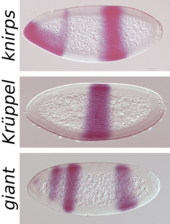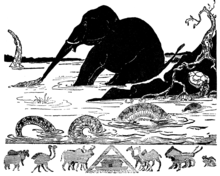Endless Forms Most Beautiful (book)
 | |
| Author | Sean B. Carroll |
|---|---|
| Country | USA |
| Subject | Evolutionary developmental biology (evo-devo) |
| Genre | Popular science |
| Publisher | W. W. Norton |
Publication date | 2005 |
| Pages | 331 |
Endless Forms Most Beautiful: The New Science of Evo Devo and the Making of the Animal Kingdom is a 2005 book by the
The book's somewhat controversial
The book has been praised by critics, and called the most important popular science book since Richard Dawkins's The Blind Watchmaker.[2]
Author

Book
Context
The book's title quotes from the last sentence of
Contents
- Part I The Making of Animals
- 1. Animal Architecture: Modern Forms, Ancient Designs
- Carroll argues that many animals have a modular design with repeated parts, as in human hand.
- Carroll argues that many animals have a modular design with repeated parts, as in
- 2. Monsters, Mutants, and Master Genes
- homeotic variants when one body part is changed into another (for instance, a fruit fly antenna becomes a leg with the Antennapediamutant).
- 3. From E. colito Elephants
- This chapter tells the tale of the genetic code, and the lac operon, showing that the environment and genetic switches together control gene expression. He introduces the evo-devo gene toolkit.
- 4. Making Babies: 25,000 Genes, Some Assembly Required
- Carroll looks at how a fruit fly's embryonic development is controlled and describes his own discoveries (back in 1994).
- 5. The Dark Matter of the Genome: Operating Instructions for the Tool Kit
- The chapter describes how genes are switched on and off in a precisely choreographed time sequence and 3-dimensional pattern in the developing embryo and how the logic can be modified by evolution to create different animal bodies.


- Part II Fossils, Genes, and the Making of Animal Diversity
- 6. The Big Bang of Animal Evolution
- The vertebrates. Carroll explains how shifting the pattern of Hoxgene expression shaped the bodies of different types of arthropods and different types of vertebrates.
- The
- 7. Little Bangs: Wings and Other Revolutionary Inventions
- This chapter explains how evolution goes to work within a lineage, specialising arthropod limbs from all being alike to "all of the different implements a humble crayfish carries", with (he writes) more gizmos than a Swiss Army knife.
- This chapter explains how evolution goes to work within a lineage,
- 8. How the Butterfly Got Its Spots
- Echoing the titles of Distal-lessgene there, until then known in limb development. Evidently, a genetic switch could be reused for different purposes.
- Echoing the titles of
- 9. Paint It Black
- Carroll looks at zebra stripes, industrial melanism in the peppered moth and the spots of big cats, all examples of the control of pattern in animals, down to molecular level.
- 10. A Beautiful Mind: The Making of Homo sapiens.
- This chapter discusses how humans differ from other apes and why there are not many structural genesfor the differences. Most of the changes are in genetic control, not in proteins.
- This chapter discusses how humans differ from other
- 11. Endless Forms Most Beautiful
- Carroll concludes by revisiting Darwin's Origin of Species, starting with how Darwin evolved the final paragraph of his book, leaving only these four words "completely untouched throughout all versions and editions". He shows that evo-devo is a cornerstone of a synthesis of evolution, genetics, and embryology, replacing the "Modern synthesis" of 20th century biology.
Illustrations
The book is illustrated with photographs, such as of
Awards
- Discover magazine's Top Science Books of the Year, 2005[10]
- USA Today's Top Science Books of the Year, 2005[10]
- Banta Prize, Wisconsin Library Association, 2006[10]
- Finalist, 2005 Los Angeles Times Book Prize (Science and Technology)[10]
- Finalist, 2006 National Academy of Sciences Communication Award[10]
Reception

The evolutionary biologist Lewis Wolpert, writing in American Scientist, called Endless Forms Most Beautiful "a beautiful and very important book." He summarized the message of the book with the words "As Darwin's theory made clear, these multitudinous forms developed as a result of small changes in offspring and natural selection of those that were better adapted to their environment. Such variation is brought about by alterations in genes that control how cells in the developing embryo behave. Thus one cannot understand evolution without understanding its fundamental relation to development of the embryo." Wolpert noted that Carroll intended to explain evo-devo, and "has brilliantly achieved what he set out to do."[12]
The evolutionary biologist
The review in BioScience noted that the book serves as a new Just So Stories, explaining the "spots, stripes, and bumps" that had attracted Rudyard Kipling's attention in his children's stories. The review praised Carroll for tackling human evolution and covering the key concepts of what Charles Darwin called the grandeur of [the evolutionary view of] life, suggesting that "Kipling would be riveted."[11]
The science writer Peter Forbes, writing in The Guardian, called it an "essential book" and its author "both a distinguished scientist ... and one of our great science writers."[13] The journalist Dick Pountain, writing in PC Pro magazine, argued that Endless Forms Most Beautiful was the most important popular science book since Richard Dawkins's The Blind Watchmaker, "and in effect a sequel [to it]."[2]
The
See also
- How the Snake Lost its Legs(Lewis I. Held, Jr., 2014)
References
- ^ doi:10.1038/4351029a.
- ^ a b Pountain, Dick (November 2016). "Nature's 3D printer exposes Pokémon Go as a hollow replica". PC Pro (265): 26.
- ^ "Our Scientists". HHMI. Howard Hughes Medical Institute. Retrieved 15 September 2017.
- ^ "LCMB Investigators". Laboratory of Cell and Molecular Biology at UW-Madison. Retrieved 14 September 2017.
- ^ Wade, Nicholas (5 July 1994). "How Nature Makes a Butterfly's Wing". The New York Times. p. C9.
- ^ "Shaw Scientist Award Recipients". Greater Milwaukee Foundation.
- ^ "SSE 2010 Stephen Jay Gould Prize". YouTube.
- ISBN 0-8014-1319-2. Retrieved 27 February 2011.
- PMID 8605997.
- ^ a b c d e Carrol, Sean B. "Endless Forms Most Beautiful". Sean B. Carroll. Retrieved 28 October 2016.
- ^ .
- doi:10.1511/2005.55.467. Archived from the originalon 2017-02-07. Retrieved 2016-10-28.
- ^ Forbes, Peter (23 March 2016). "The Serengeti Rules by Sean B Carroll review – a visionary book about how life works". The Guardian. Retrieved 15 April 2016.
- ^ S2CID 11493585.
External links
- Cornell University's Creative Machines Laboratory Archived 2018-11-14 at the Wayback Machine app to evolve three-dimensional shapes according to the principles laid out in the book
